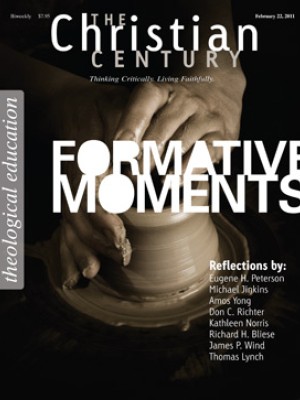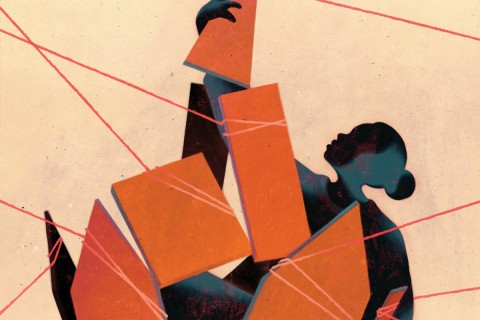At Institute of Peace religions play role in peacemaking efforts
Just steps from the Lincoln Memorial, a new building—topped by a
translucent white roof that resembles the wings of a giant dove—is
puzzling tourists and commuters alike.
What is it? Who works
there? The answer is the United States Institute of Peace, which is
often followed by some variation of "The what?"
The new
headquarters of the 27-year-old independent institute, scheduled to open
to the public in September, is designed to raise the profile of the
agency.
The new building was likened to a temple by Qamar-ul Huda,
a senior program officer in USIP's Religion and Peacemaking program.
All over Washington "we have monuments to those who fought in wars," he
said, "and rightly so, but we don't recognize the peacemakers. This
building helps." Its closest neighbors at the northwest corner of the
Washington Mall will be the Korean War and Vietnam War memorials.
The
new site could draw attention to Huda's small but increasingly active
program, which studies the role of religion in war and peace and engages
religious leaders in peacemaking.
Plenty of universities and
independent think tanks are working at the nexus of religion and peace,
said Ambassador Dane F. Smith, a senior adviser on Darfur at the State
Department who has written a book about American peace-building
institutions.
Read our latest issue or browse back issues.
But USIP is a congressionally chartered,
taxpayer-funded institute. Its willingness to work with religious
leaders contrasts with the conventional approach elsewhere in
government, said Smith. "The guidance to diplomats in the field is that
they can meet with religious leaders—but don't go too far," Smith said.
The
325 employees at the nonpartisan institute work outside the
administration's foreign policy apparatus at the neighboring State
Department, and they can't make government policy. The board, appointed
by the president, must be equally divided between Republicans and
Democrats.
USIP's annual $44 million operating budget is dwarfed
by the State Department's—$54 billion in fiscal year 2010. Congress
allotted $100 million for the new, 150,000-square-foot headquarters,
which was designed by Massachusetts-based architect Moshe Safdie and
will cost $183 million. USIP must raise the balance from the private
sector.
A group of donors has paid for a wing named for Madeleine
Albright, secretary of state in the Clinton White House, who probed the
role of religion in foreign affairs in her 2006 book, The Mighty and the Almighty.
Chevron Corporation donated a wing named for George Schultz, who held
the job under President Reagan, and defense contractor Lockheed Martin
endowed a lecture series with a $1 million gift.
With advanced
teleconferencing capabilities, the building will allow peacemakers from
the world over to meet virtually. A large interactive exhibition space
is expected to draw up to 500,000 visitors annually to highlight the
institute's scholarship and work in the field.
That fieldwork
includes efforts to integrate former rebels in the Niger Delta back into
their communities, creating a database on human rights violations in
Afghanistan and hosting a roundtable of experts on the developing crisis
on the Korean Peninsula.
The institute's Religion and
Peacemaking program, which has a $1 million budget and four staffers,
focuses on places where religion may hold the keys to peace.
For
example, the program is organizing exchanges between Muslims in Iran and
the U.S. In Afghanistan, it is teaching conflict management skills to
Islamic religious scholars. In Colombia, it helped organize a conference
of Catholic and Protestant women seeking ways to reduce violence
through their churches.
David Smock, who heads the Religion and
Peacemaking program, helped broker a 2005 peace agreement between
Muslims and Christians in Nigeria.
An ordained minister in the
United Church of Christ, Smock worked with a Nigerian pastor and imam at
the negotiating table. Their story was featured in a documentary, The Imam and the Pastor, which the agency dubbed into Arabic and sent to Iraq to be used as a model of successful interfaith cooperation.
Huda
also leads a project to distribute a textbook on conflict resolution to
Islamic schools in Pakistan. Written in Urdu by Huda and a group of
Pakistani religious scholars, Peace and Conflict Resolution in Islam: A Textbook for Students
explores the personal and societal roots of conflict and encourages
students to examine their own biases. It is now used by 100 teachers in
60 madrassas.
Huda holds a doctorate in Islamic studies from UCLA,
and he also studied in traditional Islamic seminaries in Pakistan,
Egypt and Syria. He said USIP staff—as government employees—are mindful
of the separation of church and state and are careful not to promote any
religion. But they also don't shy away from trying to work with
religionists and draw upon religious traditions to foster peace.
Seeing
religion less as a root of conflict and more as an opportunity for
peace is welcome and rather rare within American foreign policy circles,
said Lisa Schirch, a professor at Eastern Mennonite University's
graduate Center for Justice and Peacebuilding.
"Current research
is showing how the U.S. government often underplays the role of religion
in diplomacy," Schirch said. "For too long, it has overlooked religious
leaders' moral influence, and their power to promote peace outside more
formal diplomatic channels." —RNS





